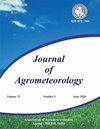基于泛蒸发的滴灌水平对印度乌代布尔和雷瓦地区番石榴生长表现的影响
Q3 Agricultural and Biological Sciences
引用次数: 0
摘要
在拉贾斯坦邦乌代布尔和中央邦雷瓦这两个地方,对 4 年树龄的番石榴果园进行了为期三年(2019-20 年、2020-21 年和 2021-22 年)的田间试验,间距为 3×2 米,采用滴灌处理。与当地对照相比,不同的泛蒸发滴灌水平(70、80、90 和 100% Epan)对植物生长、产量贡献参数、果实产量和水分利用效率有显著影响。在乌代布尔和雷瓦地区的现有气候条件下,高密度种植番石榴树的日灌溉需水量分别为 7.8 至 26.3 升/株/天和 4.5 至 26.5 升/株/天。在所有基于盘面蒸发的滴灌水平中,乌代布尔和雷瓦地区的高密度种植(HDP)番石榴果园滴灌的最佳灌溉水平为日盘面蒸发量的 80% 和 90%,果实产量(37.3 和 30.7a-1)和灌溉水利用效率(0.359 和 0.263tha-1-cm)最高,节水率(29.2 和 22.2%)分别高于当地对照。研究结果将有助于拉贾斯坦邦和中央邦缺水地区的农民、政策制定者和灌溉管理人员保护现有淡水资源。本文章由计算机程序翻译,如有差异,请以英文原文为准。
Effects of pan evaporation-based drip irrigation levels on performance of guava grown in Udaipur and Rewa regions of India
A field experiment was conducted for three years (2019-20, 2020-21 and 2021-22) on 4 years old guava orchard established at 3×2 m spacing with drip irrigation treatments at two locations viz. Udaipur Rajasthan and, Rewa, Madhya Pradesh. Plant growth, yield contributing parameters, fruit yield and water use efficiency was significantly affected by different pan evaporation-based drip irrigation levels (70, 80, 90 & 100% of Epan) over local control. In existing climatic conditions of Udaipur and Rewa regions, the daily irrigation water requirement of high-density planting guava tree was varied from 7.8 to 26.3 and 4.5 to 26.5 liter/plant/day, respectively. Among all the pan evaporation-based drip irrigation levels, the irrigation supplied at 80% and 90% of daily pan evaporation were found as best approach for irrigating high density plantation (HDP) guava orchard through drip irrigation in Udaipur & Rewa regions with maximum fruit yield (37.3 & 30.7tha-1), irrigation water use efficiency (0.359 & 0.263tha-1-cm) along with significant water saving (29.2 & 22.2%), respectively over local control. Results will help farmers, policy makers and irrigation managers to conserve available fresh water resources in water scares regions of Rajasthan and Madhya Pradesh.
求助全文
通过发布文献求助,成功后即可免费获取论文全文。
去求助
来源期刊

Journal of Agrometeorology
农林科学-农艺学
CiteScore
1.40
自引率
0.00%
发文量
95
审稿时长
>12 weeks
期刊介绍:
The Journal of Agrometeorology (ISSN 0972-1665) , is a quarterly publication of Association of Agrometeorologists appearing in March, June, September and December. Since its beginning in 1999 till 2016, it was a half yearly publication appearing in June and December. In addition to regular issues, Association also brings out the special issues of the journal covering selected papers presented in seminar symposia organized by the Association.
 求助内容:
求助内容: 应助结果提醒方式:
应助结果提醒方式:


